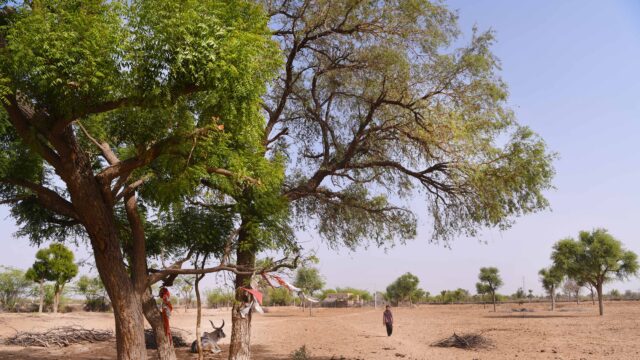Sometime in the 15th century, a new community taking shape in an arid corner of western Rajasthan was listing out guiding principles for its flock. At least eight of the eventual 29 canons that were laid down for life, called for safeguarding the environment and empathy for all living beings. These tenets instruct adherents to share natural resources with fauna and flora, and also to provide refuge to forsaken animals. Followers were forbidden from cutting down green trees, and to ensure firewood was free of all life-form before use. That this transpired long before eco-friendly practices became heartfelt, and sustainability catchphrases fashionable, is a marker of the founder Guru Jambheshwar’s farsightedness. Born in 1451 in Nagaur district, Jambhoji, as he is also called, established the Bishnoi sect in 1485, aged 34 years. Six centuries on, his followers continue to believe in the sanctity of all life. It is no surprise therefore, that they adhere to a strict vegetarian diet or eschew clothes dyed blue because the colour is extracted from the indigo plant.


Bishnois are not only fiercely protective of trees, plants and shrubs, they also go to great lengths to protect black bucks, chinkaras, and other wildlife. The animal shelter at the Guru Jambheshwar Mandir in Jajiwal Dhora is one such example. Located 30 kilometres northeast of Jodhpur atop a large sand dune, it provides a panoramic view of the fascinating Thar landscape that encircles it. We are greeted by a beautiful peacock believed to be the incarnate of a Bishnoi saint. Unaffected by our presence, it goes about its business unhurriedly as we walk around the pristine complex. Set to the back of the temple premises are airy enclosures that house abandoned or orphaned black bucks, chinkaras, and rabbits. Visitors are encouraged to interact with the friendly inmates by offering them food in the presence of care-takers. Donations for their welfare and upkeep of the facility are welcome.

Bishnois are by and large an agrarian community and mostly live in dhanis (family clusters) around their farmlands. “Education for all, is an equally important aspect of our creed,” Sarita Bishnoi informs us. The eldest among a dozen cousins, all at different stages of schooling or college, she has nearly completed her master’s degree in history and professes an interest in teaching thereafter. We have driven out from Rohet Garh to Khiya Ram ki Dhani, a couple of kilometres beyond Dhundli village in the Pali district. Sarita’s parents, uncles and aunts are at work a short distance away, and the cousins are holding the fort, a neat and spotless walled compound with thatched jhopras (mud huts), and a summer kitchen in the outdoors called thuno. An ola (cattle pen) is located to the front of the homestead, while its residents ruminate under the shade of a revered khejri tree. Khiya Ram ki Dhani’s simple, slow-paced existence, has found it immortalised on celluloid in Wes Anderson’s 2007 film The Darjeeling Limited. “Since the shooting, he only wants to become a film actor,” the cousins teasingly point to a young lad, who obligingly flexes his biceps as we prepare to leave.

Historically Speaking It was an unwavering faith in Jambhoji’s teachings that led to the Khejarli Massacre of 1730, when 363 nature-loving Bishnois met a brutal end while preventing the felling of khejri trees by soldiers of the Maharaja of Jodhpur. This protest, led by a young woman called Amrita Devi, is often referred to as the Bishnoi Movement, and is believed to be the precursor to modern day activism like the tree-hugging Chipko Andolan of Uttarakhand.
For similar immersive experiences: https://houseofrohet.com/



